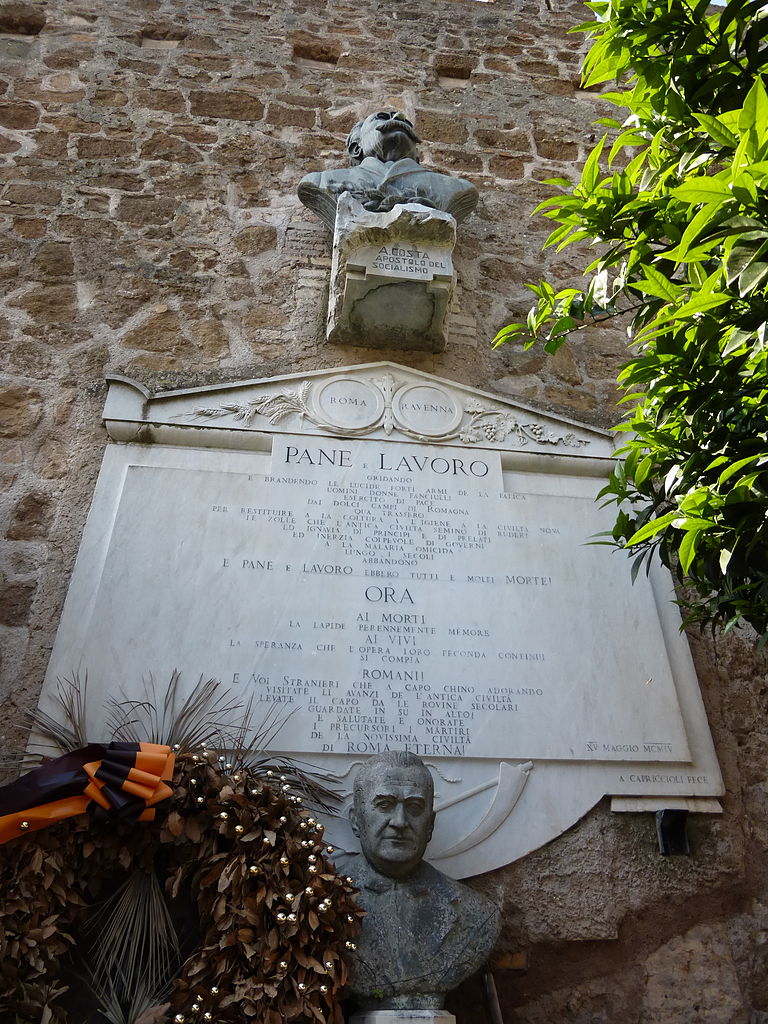Ostia - From the eleventh century to the present day
From the eleventh to the fourteenth century Ostian marble was reused in the cathedrals of Pisa, Florence, Amalfi and Orvieto. A document from 1191 mentions a spot in Ostia called calcaria. This is a reference to a lime-kiln, in which marble (floors, statues, inscriptions) was burned to be used as mortar. Several lime-kilns have been excavated. The search for marble was easy, because Ostia was not entirely buried. In August 1190 Richard Coeur de Lion landed at the mouth of the Tiber. He saw "immense ruins of ancient walls", and a place called "Le Far de Rume" - the remains of the lighthouse (Pharos) of Portus. Vast amounts of bricks must also have been dug up, to be used in Rome.
In the fifteenth century the castle of Gregoriopolis was rebuilt by cardinal Giuliano della Rovere (this is the present castle). It had to protect Rome from incursions by raiders. In 1557 there was a major inundation. The meandering Tiber changed its course. The branch of the Tiber along the castle was cut off, so that the castle became useless. The old branch is now filled with earth and known as Fiume Morto ("Dead River"). The inundation of 1557 also destroyed a large stretch of the ancient Tiber quays.
 |
| The borgo of the modern village Ostia Antica. Photo: Parco Archeologico di Ostia Antica. |
From the fifteenth to eighteenth century promising ruins were searched by foreign visitors for inscriptions and statues. These ended up in private collections in England, France, Portugal, Spain and Russia (now mostly in national museums). The random searching of the ruins was forbidden by Carlo Fea, director general of antiquities, in the early nineteenth century. The first excavations, initiated by pope Pius VII (Ostia belonged to the Vatican), were carried out by Giuseppe Petrini in the years 1801-1805. Between 1824 and 1834 there was a renewed hunt for treasure. More or less structural activities began once more in 1855, under the auspices of pope Pius IX. The excavators were uncle and nephew Pietro Ercole and Carlo Ludovico Visconti. They too focused on inscriptions, statues, mosaics, and paintings, that were taken to the Vatican museums. Sometimes marble and granite was taken to Rome as building material. From 1870 Ostia was no longer a papal domain, but owned by the new Italian state. The excavations were continued by Pietro Rosa and Rodolfo Lanciani. In 1887 Hermann Dessau published the Ostian inscriptions in the Corpus Inscriptionum Latinarum (CIL), volume XIV.
Wealthy foreigners started to visit Ostia as tourists in the 19th century. The site was reached with some difficulty with carriages. The railway between Rome and Ostia was opened in 1924. The present-day museum was built. Starting in the late nineteenth century the marshes were drained and restored to agriculture. This was the work of colonists from Ravenna. The malaria was completely eradicated after the Second World War by the Americans, who sprayed DDT.
 |
|
A monument in the modern village for the colonists from Ravenna who drained the marshes of Ostia. Photo: Wikimedia, Lalupa. |
Truly scientific research started in 1907 by Dante Vaglieri. The north-east part of the city was now excavated systematically. Vaglieri died in 1913. The year before, the first monograph about Ostia had been published: "Ostia, Colonia Romana", by Ludovico Paschetto. Important work was also done by the French archaeologist Jérôme Carcopino.
Vaglieri was succeeded by Guido Calza, who was supported by architect Italo Gismondi and inspector Raffaele Finelli. Slowly more ruins were unearthed. In 1930 a supplement to the CIL appeared. In 1938 one-third of the city had been excavated. But then extensive, hurried excavations began, lasting until 1942. The initiator was Mussolini, who wanted to present Ostia during a world-fair, the "Esposizione Universale di Roma" (EUR). The excavated area was more than doubled. More than 600.000 cubic metres of earth were removed, that had reached a height of 4 to 12 metres above the ancient street level. Needless to say that much information was not recorded during these five years. The world-fair never took place. Calza died in 1946.
After the Second World War the series "Scavi di Ostia" was published. Excavations continued on a very small scale. In 1960 a monumental, historical study about Ostia was published: "Roman Ostia", by Russell Meiggs, working in Oxford (an updated edition appeared in 1973). A detailed archaeological guide, written by Carlo Pavolini, was published in 1983 (updated in 2006). Geophysical research by the German Archaeological Institute and the American Academy in Rome provided a wealth of information about the unexcavated area, and led to several important discoveries, such as that of a Christian basilica, and of a small harbour in the north-west part of the city. Similar geophysical research also took place in Portus and on the Isola Sacra by the University of Southampton. The University of London contributed to investigations of the area to the south of Ostia. The Ostia bibliography on this website contained over 3200 titles in 2022.
In Scavi di Ostia volume I the nomenclature of Ostian buildings was standardized. In antiquity Ostia was divided in five or more regions, but we do not know their borders. The excavators divided the city in five modern regions, and furthermore in blocks (insulae) and then individual buildings. An example of the numbering system is: Tempio d'Ercole (Temple of Hercules), I,XV,5 = building 5 in block 15 in region 1.